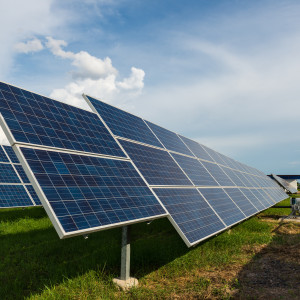At the beginning of 2018, the outlook for solar power was at best only partially sunny. While 2017 set new records for solar cell installation, protective tariffs placed on panels manufactured overseas threatened to hamper industry growth this year. Meanwhile, the industry itself was in a period of transition, as companies struggled to turn sales and installations into profits before they ran out of venture capital money. Despite the worries, recently released numbers show that the solar industry is continuing to thrive. According to a new report by market research firm GTM Research, America’s solar industry has had a strong start to 2018, though the tariffs have slowed progress somewhat.
In the first quarter of 2018, the solar industry installed 1.4 gigawatts of utility-scale solar cells. This is the 10th consecutive quarter of greater than 1 GW installation, a sign that utilities around the country continue to invest in solar.
“The solar industry had a strong showing in the first quarter,” said SEIA President and CEO Abigail Ross Hopper. “This data shows that solar has become a common-sense option for much of the U.S. and is too strong to be set back for long, even in light of the tariffs. States from California to Florida have stepped up with smart policies that will drive investment for years to come.”
Early solar energy projects were centered in states like California, which had favorable weather and regulatory climates. More recently, community solar projects, where power generated by one solar panel installation is shared among an entire community, are bringing solar panels to less-expected states. Minnesota alone added more than 100 MW of community solar in Q1, helping to push non-residential solar to its fourth-highest quarter ever.
This is another sign of how solar power is changing as it matures, shifting from private residential installation towards a more traditional, utility-based model. Even as solar installation over all has grown, residential installations remained flat in 2018, following a 15 percent contraction in 2017.
The market plateau is preferable to a decrease in residential installation, but still leaves that sector of the industry on shaky footing, especially after the first wave of converts has installed their solar systems. Especially in areas where solar photovoltic (PV) cells were widely adopted initally, continuing to grow will be difficult for the industry.
“This is a promising indicator that constraints to residential PV growth like segment-wide customer acquisition challenges and national installer pullback are abating,” GTM Senior Analyst Austin Perea said. “However, these problems are not entirely solved, as we’re seeing slowdowns in states with a relatively high penetration of PV installations.”
These states include Maryland, New York, and California, which were in the top five residential solar markets in 2017. Analysts expect that this downward trend will continue in 2018, but are hopeful that things will correct in 2019.
Even with its growing pains, solar’s growth puts in a position where it can’t be ignored. Fifty-five percent of all new electric generating capacity brought online in the U.S. came from solar this quarter, which was the second quarter in which solar power comprised the largest share of new capacity additions.
At the end of the day, America’s solar industry is cautiously optimistic about the future. Although growth numbers are lower than they were last year, expectations for the early 2020s remain rosy and the industry expects that by 2023, more than 14 GW of solar will be installed annually and overall installed capacity will double by that time.

